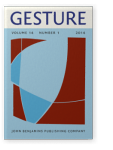Article published In:
GestureVol. 14:1 (2014) ► pp.97–107
Genie’s middle-finger points and signs
A case study
The ubiquity of index-finger pointing, and its early emergence in child development, has suggested that such pointing may be biologically-determined. However, cross-cultural variation in the form of pointing has also been noted, with some observations of middle-finger pointing. Here we examine the limited corpus of publically-available video data on the signs and gestures of Genie, a child who suffered severe social and linguistic deprivation throughout her childhood. These data suggest that Genie favored the use of the middle finger in points, in ASL signs that have an index-finger target handshape, and in object exploration. We speculate that middle-finger pointing in children may reflect an articulatory preference that is not limited to pointing, but that may encompass a range of manual behaviors.
References
Ann, Jean
(
1996)
On the relation between ease of articulation and frequency of occurrence of handshapes in two sign languages.
Lingua, 981, 19–41.


Butterworth, George
(
2003)
Pointing is the royal road to language for babies. In
Sotaro Kita (Ed.),
Pointing: Where language, culture, and cognition meet (pp. 9–33). Mahwah, NJ: Lawrence Erlbaum Associates.

Cheek, Adrianne, Kearsy Cormier, Ann Repp, & Richard P. Meier
(
2001)
Prelinguistic gesture predicts mastery and error in the production of first signs.
Language, 771, 292–323.


Cochet, Hélène & Jacques Vauclair
Curtiss, Susan
(
1977)
Genie: A psycholinguistic study of a modern-day “wild child”. New York: Academic Press.

Curtiss, Susan, Victoria Fromkin, Stephen Krashen, David Rigler, & Marilyn Rigler
(
1974)
The linguistic development of Genie.
Language, 501, 528–554.


Deuchar, Margaret
(
1984)
British sign language. London: Routledge & Kegan Paul.

Epps, Julien, Serge Lichman, & Mike Wu
(
2006)
A study of hand shape use in table top gesture interaction.
CHI ’06 Extended abstracts on human factors in computing systems
(pp. 748–753). New York: Association for Computing Machinery.

.
Fromkin, Victoria, Stephen Krashen, Susan Curtiss, David Rigler, & Marilyn Rigler
(
1974)
The development of language in Genie: a case of language acquisition beyond the “critical period”.
Brain and Language, 11, 81–107.


Goldin-Meadow, Susan, Carolyn Mylander, & Cynthia Butcher
(
1995)
The resilience of combinatorial structure at the word level: Morphology in self-styled gesture systems.
Cognition, 561, 195–262.


Kendon, Adam & Laura Versante
(
2003)
Pointing by hand in “Neapolitan”. In
Sotaro Kita (Ed.),
Pointing: Where language, culture, and cognition meet (pp. 109–137). Mahwah, NJ: Lawrence Erlbaum Associates.

Kita, Sotaro
(
2003)
Pointing: A foundational building block of human communication. In
Sotaro Kita (Ed.),
Pointing: Where language, culture, and cognition meet (pp. 1–8). Mahwah, NJ: Lawrence Erlbaum Associates.


Marentette, Paula F. & Rachel I. Mayberry
(
2000)
Principles for an emerging phonological system: A case study of early ASL acquisition. In
Charlene Chamberlain,
Jill P. Morford, &
Rachel I. Mayberry (Eds.),
Language acquisition by eye (pp. 71–90). Mahwah, NJ: Lawrence Erlbaum Associates.

Matthews, Danielle, Tanya Behne, Elena Lieven, & Michael Tomasello
(
2012)
Origins of the human pointing gesture: a training study.
Developmental Science, 151, 817–829.


Morgan, Gary, Sarah Barrett-Jones, & Helen Stoneham
(
2007)
The first signs of language: Phonological development in British Sign Language.
Applied Psycholinguistics, 281, 3–22.


Povinelli, Daniel J. & D. Richard Davis
(
1994)
Differences between chimpanzees (Pan trogolodytes) and humans (Homo sapiens) in the resting state of the index finger: Implications for pointing.
Journal of Comparative Psychology, 1081, 134–139.


Sherzer, Joel
(
1973)
Verbal and nonverbal deixis: The pointed lip gesture among the San Blas Cuna.
Language in Society, 21, 117–131.


Sherzer, Joel
(
1983)
Kuna ways of speaking: An ethnographic perspective. Austin: University of Texas Press.

Shield, Aaron & Richard P. Meier
(
2012)
Palm reversal errors in native-signing children with autism.
Journal of Communication Disorders, 451, 439–454.


Van Boven, Robert W., Roy H. Hamilton, Thomas Kauffman, Julian Paul Keenan, & Alvaro Pascual-Leone
(
2000)
Tactile spatial resolution in blind Braille readers.
Neurology, 541, 2230–2236.


Wilkins, David
(
2003)
Why pointing with the index finger is not a universal (in sociocultural and semiotic terms). In
Sotaro Kita (Ed.),
Pointing: Where language, culture, and cognition meet (pp. 171–215). Mahwah, NJ: Lawrence Erlbaum Associates.

Woodward, James
(
1982)
Single finger extension: For a theory of naturalness in sign language phonology.
Sign Language Studies, 371, 289–304.


Cited by
Cited by 2 other publications
Gawne, Lauren, Chelsea Krajcik, Helene N. Andreassen, Andrea L. Berez-Kroeker & Barbara F. Kelly
LUTZENBERGER, Hannah, Paula FIKKERT, Connie DE VOS & Onno CRASBORN
2023.
Development of sign phonology in Kata Kolok.
Journal of Child Language ► pp. 1 ff.

This list is based on CrossRef data as of 2 july 2024. Please note that it may not be complete. Sources presented here have been supplied by the respective publishers.
Any errors therein should be reported to them.
